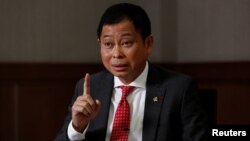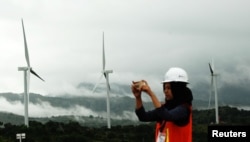Indonesia says it is unlikely to meet renewable energy targets it set after the Paris climate agreement, causing critics to call for changes in government policy.
At the recent Indonesia Clean Energy Forum (ICEF) in Jakarta, Indonesian Minister of Energy and Mineral Resources Ignasius Jonan said he is pessimistic Indonesia will be able to meet its target of having 23 percent of its energy come from renewables such as solar and wind by 2025.
“I’m worried we can’t reach 23 percent. Maybe we will try until 20 percent more or less,” Jonan said
According to Fabby Tumiwa, the executive director of Institute for Essential Services Reform (IESR), Jonan’s statement reflected the current condition where development of renewable energy is stalling. In July, President Joko “Jokowi” Widodo launched two wind power plants in Indonesia, a 75 Megawatt plant in Sidrap and a 70 Megawatt plant in Jeneponto, both in South Sulawesi.
But even then, renewable energy is only 13 percent of the total electricity produced in the country, mainly from geothermal and hydro. “And for the last three years, there hasn’t been a new and significant project for renewable energy that is being developed,” Tumiwa told VOA.
Perception as hindrance
Tumiwa said renewable energy is still perceived as more expensive because of the intermittent nature of solar and wind power plants.
“That is actually not the case,” he added.
According to the data from the Ministry of Energy and Mineral Resources, up until the third quarter of 2018, investment in renewable energy in Indonesia was only $1.16 billion, a decrease from $1.34 billion in 2017 and $1.57 billion in 2016.
“The number shows that the renewable energy sector is not lucrative for investors,” said Tumiwa.
Dependence on coal
More than 80 percent of the energy mix in Indonesia comes from fossil fuels, with coal power plants still the main source of electricity. Based on the Brown to Green Report published by Climate Transparency, Indonesia’s state-owned utility expects coal use to double from 2017 to 2025.
Adhityani Putri, the founder of Center for Energy Research Asia (CERA), said in its commitment to the Paris Agreement, Indonesia has already taken into account the plan to build a 35 Megawatt coal power plant in its Nationally Determined Contribution (NDC) on top of the 23 percent renewable energy target.
“So it has already incorporated the fact that it would be adding a lot of coal in the next 10 years to the system,” she told VOA.
According to Putri, coal power plants have become an established business process in the last two decades. “The players are known, they are comfortable with the risks. Many people benefited from the supply chains, from coal miners to the middlemen. And finally the banks are comfortable with financing coals, they don’t understand renewables, they know coal,” she added.
Putri argued that renewable energy would be cheaper even though the technology costs a little more than conventional plants. But the government put a cap on coal prices through its Domestic Market Obligation (DMO).“And on policy, the government created policies as if renewables and fossil fuels are on the same level playing field, they are not. The characteristics of both markets are different, one is transportable while (renewable energy) is site specific and more on the smaller and medium scale,” she said adding that without policies that can accommodate growth on renewable, it would be hard to attract investors and business proponents in the sector.
5,000 Megawatt per year
Tumiwa asserted the Indonesian government needs to accelerate the development of renewable energy and add 35 Gigawatts to its energy mix by 2025.
“Of course if we only add 800 to 1000 Megawatts (of renewables) per year it won’t be enough. At least we need to grow 4,000 to 5,000 Megawatts per year to meet the 23 percent target,” he added.
Last week, the Ministry of Energy and Mineral Resources issued a ministerial decree no. 49/2018 on rooftop solar power plant systems to encourage people to install the system in exchange for reduced electricity fees.
Tumiwa lauded the effort but expressed skepticism on how far it can encourage the public to invest on solar rooftop. “We did a survey two months ago and found out the potential for solar rooftop in Indonesia is about 13 percent. This equals to 4.5 million household. But these early followers would invest only if they can get the benefit,” he said.








